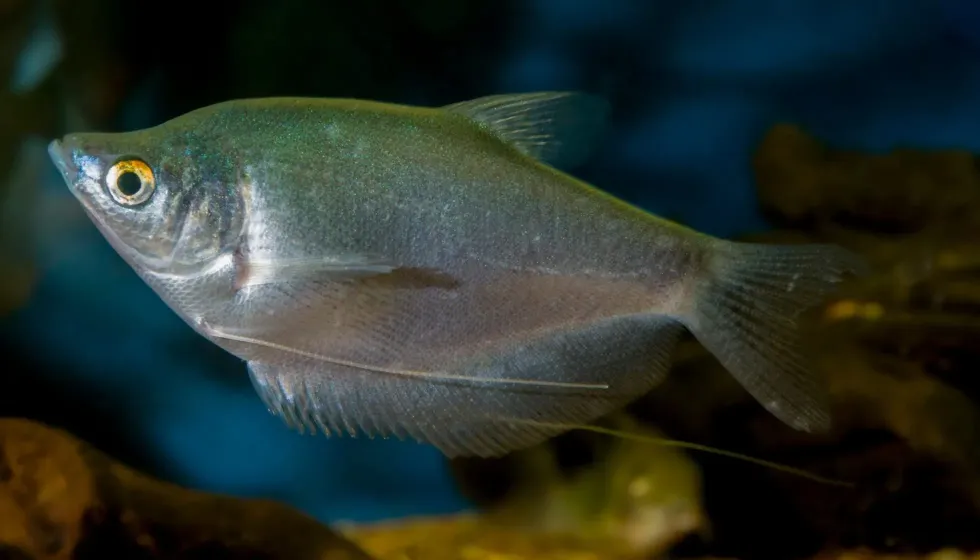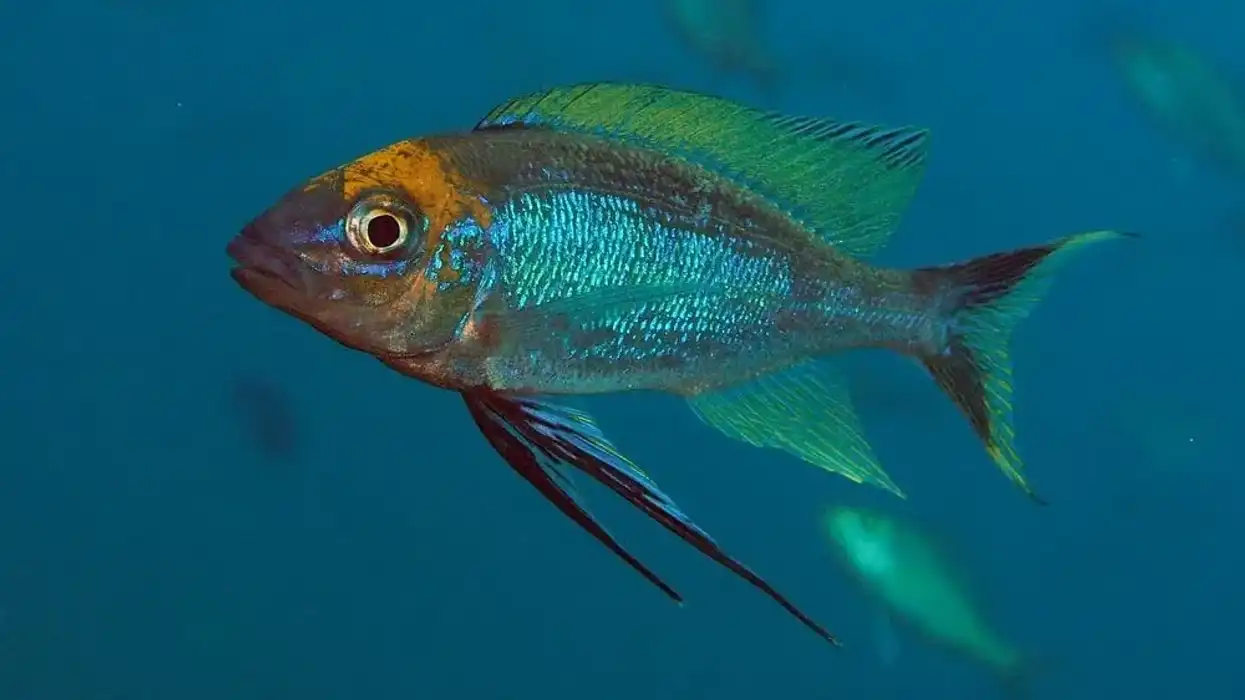Moonlight gouramis, known by the scientific name Trichopodus microlepis (previously Trichogaster microlepis), are small iridescent labyrinth fish found around Southeast Asia. They are no ordinary fish and use intricate bubble nests to reproduce.
What's more, is that they are popular pets in home aquariums.
This particular gourami species was first identified in 1861 by Gunther and is known by several different names, including moonbeam and moonlight gourami.
However, these little fish are not the most peaceful of the gourami family and can be aggressive to other fish, so gourami owners may want to consider honey gouramis, or female powder blue gouramis if you have lots of other existing pet fish as these are the most peaceful gouramis.
Perhaps you would like to find out more about moonlight gouramis, or maybe you are considering them as a pet, either way here at Kidadl we have plenty of facts about these fish, and how to take care of them.
What's more, if you are looking for further fish facts, check out our articles on bonito fish and mahi mahi fish.
Moonlight Gourami Interesting Facts
What type of animal is a moonlight gourami?
The moonlight gourami is a fish species known as a labyrinth fish. Its scientific name is Trichopodus microlepis.
What class of animal does a moonlight gourami belong to?
Gouramis belong in the Actinopterygii fish class of the animal kingdom.
How many moonlight gouramis are there in the world?
The exact population of gouramis isn't known. However, we do know that their populations are stable, and they are rated Least Concern by the IUCN.
Where does a moonlight gourami live?
They live in the Mekong River in Cambodia. They can also be found across Southeast Asia in Vietnam and in the Chao Phraya Basins in Thailand. These climates have a warm temperature
What is a moonlight gourami's habitat?
They enjoy habitats with plenty of floating plants and hiding places such as ponds, bogs, swamps, and lakes. As pets, they like to swim in mid to high aquarium areas with plenty of floating plants and java ferns and a water temperature up to 86 F (30 C). They are vulnerable to sudden water changes, so stability is key.
Who do moonlight gouramis live with?
The moonlight gourami (Trichopodus microlepis) lives alongside other labyrinth fish. If you are keeping them as a pet, try to keep just one male with more than one female.
If you are planning to have many male gouramis, ensure your tank is big enough for each male to identify its own patch of territory, though be warned that if they meet they are likely to fight until the death!
In some parts of the world such as other parts of Asia and in Colombia and South America, these gouramis are considered an invasive alien species. It's believed they have escaped from breeders and into the wild.
How long does a moonlight gourami live?
This species of gourami fish lives for approximately four years
How do they reproduce?
Moonlight gouramis have a truly unique breeding pattern whereby males create a bubble nest. They blow bubbles out of their thick salvia which then join together to form a nest of bubbles.
The male fish will then try to court the female by performing a remarkable courtship dance. If a female accepts him, the male begins the spawning process in the breeding pair.
The female will embrace the male fish, and he will push her backward which triggers her to release her eggs. As the fish remain together, the male fertilizes the eggs. The male fish then picks up the eggs and places them into the bubble nest he built.
The eggs will then hatch in the bubble nest, after two to three days. Both of the parent fish play an active role within the breeding pair.
Males protectively guard the baby fish in the bubble nest and they return any fry that escapes until the fish become free-swimming. Across a spawning season, females can lay up to 2000 eggs!
If you are using a breeding tank aquarium, it is important to remove male fish from the aquarium after the fry becomes free-swimming. At this point, remember to feed them extra tiny food!
Food such as ground flake food is a good idea for the fry. If you have these fish as a pet, it is essential to use a separate breeding tank as many tank mates will consider both the eggs and the baby fry fish as a tasty snack!
What is their conservation status?
Previously known by the name 'Trichogaster microlepis' these fish are listed as Least Concern on the IUCN list. However, it's not uncommon to find them on the menu in Southeast Asia as a tasty delicacy.
Moonlight Gourami Fun Facts
What do moonlight gouramis look like?
A moonlight gourami's profile is long, slender, and sleek. They get their name from the moonlight color of their skin and they are a silvery color with a hint of green.
Their head shape is unique, and different when compared to other gourami fish species because they have a concave slope shape. They have a dorsal fin that has up to three to four spines. Their pelvic fins are long and float away from the body, resembling needles.
They also have a unique labyrinth organ. This labyrinth organ allows them to breathe air from above the surface of the water.

How cute are they?
Moonlight gourami fish are very iridescent and this sparkly sheen makes them very cute! Adult moonlight gouramis have a green tint, and males have an orange to red tint around the pelvic fin.
Both females and males have an unusual red iris which is very different from other fish species. After the eggs have hatched, and once the little fry fish become free swimming, they are certainly very cute!
How do they communicate?
Like many fish species, male fish use a change of color in their scales to communicate to females. These fish also use ventral fins to communicate. These long willowy ventral fins contain lots of sensory cells that help them to find food and navigate their way through the waters.
How big is a moonlight gourami?
The average moonlight gourami size is up to 5.1 in (13cm).
How fast can a moonlight gourami swim?
The exact speed of these fish isn't known, though they are very swift, thanks to their swift moonlight gourami profile!
How much does a moonlight gourami weigh?
The weight of this species isn't documented, but as they are so slender and just 5.1 in (13 cm) in length, we can assume they would not weigh very much!
What are their male and female names of the species?
There isn't a particular name for the males and females of this species. However, you can tell them apart from the color of their scales.
Females have a faint yellow hue in their pelvic fin, and their dorsal fins are more short and round compared to their male counterparts.
Throughout spawning, in males, the reddish streak-like ventral fins will intensify and develop into a darker shade of crimson around the female. In both males and females the anal fin that trails along the body to the bottom of the tail is a greenish hue.
What would you call a baby moonlight gourami?
A baby moonlight gourami is known as a fry. After it has commenced free-swimming, it is known as juvenile moonlight gourami or juvenile moonbeam gourami.
What do they eat?
Gouramis are true omnivores and are not fussy when it comes to food. However, they do love baby brine shrimp and live foods.
If you are keeping moonlight gourami in an aquarium tank, they will love most fish food you can find at the pet store. They will eat flaked food, frozen food, and live foods. It's a good idea to give them a variety of foods to ensure they have a balanced diet.
Are they dangerous?
They are not dangerous to humans. But, if you are keeping them in an aquarium tank, be mindful of which tank mates you place your gouramis with, as many other fin nippers are attracted to their long fins.
Would they make a good pet?
Moonlight gouramis are a popular choice for an aquarium but you must carefully consider prospective moonlight gourami tank mates. Gouramis are exceptionally territorial and are not community fish.
Do not place them with a goldfish, an angelfish (such as an orange angelfish), or any fish that has a long bright tail as these gouramis are known as fin nippers. This means they find these fish attractive and pursue them, nipping their fins!
Moonlight gouramis go well with tetras and barbs. You can keep them in pairs and offer them plenty of hiding spots within the tank.
They tend to bully and intimidate weaker fish and can be quite aggressive towards their tank mates. They are not aggressive to humans though, so don't worry!
When it comes to plants in the aquarium, put plenty of thick hardy plant matter such as java fern. As gouramis are true snackers, they will eat fine plants!
You will also need to keep a close eye on the aquarium temperature, as they are very susceptible to water changes. 86 F (30 C) is the perfect water temperature, and it is important to maintain a dark, subdued lighting environment.
Keeping the tank in perfect condition will really help you to appreciate their sparkling beauty. A minimum tank size of 30 gallons (136 L) is recommended for these fish.
Bear in mind the tank size if you are keeping lots of male fish, and use a different breeding tank aquarium if you are pairing up your fish, as many tank mates will consider the fry and eggs food. The breeding pair will require lots of floating plants to anchor their bubble nests.
You can find moonlight gourami for sale amongst many other gourami species.
Did you know...
Just like all labyrinth fish species, the moonlight gourami has an extraordinary lung-like organ that allows it to inhale and gulp air directly from above the surface of the water! This ability to breathe air directly helps them to survive in the wild in areas with low oxygen.
Although they like to gulp air, if you choose to have gouramis as pets, they still require an aquarium tank with great filtration and plenty of plants.
Why is it also called a moonbeam gourami?
Thanks to their iridescent glow and floaty nature, this fish species takes its name from the moonlight itself! The males can also change their orange to red tint around the spawning season. Just like the moon changes color of intensity.
What survival mechanisms do moonlight gouramis have?
Thanks to their unique ability to go to the surface of the water and breathe air, gouramis can live in areas with low oxygen. That's not their only incredible survival mechanism. The bubble nest for the eggs acts as a barrier or a level of protection against many other species.
Here at Kidadl, we have carefully created lots of interesting family-friendly animal facts for everyone to discover! Learn more about some other fish from our ladyfish facts and Vendace fish facts pages.
You can even occupy yourself at home by coloring in one of our free printable moonlight gouramis coloring pages.










